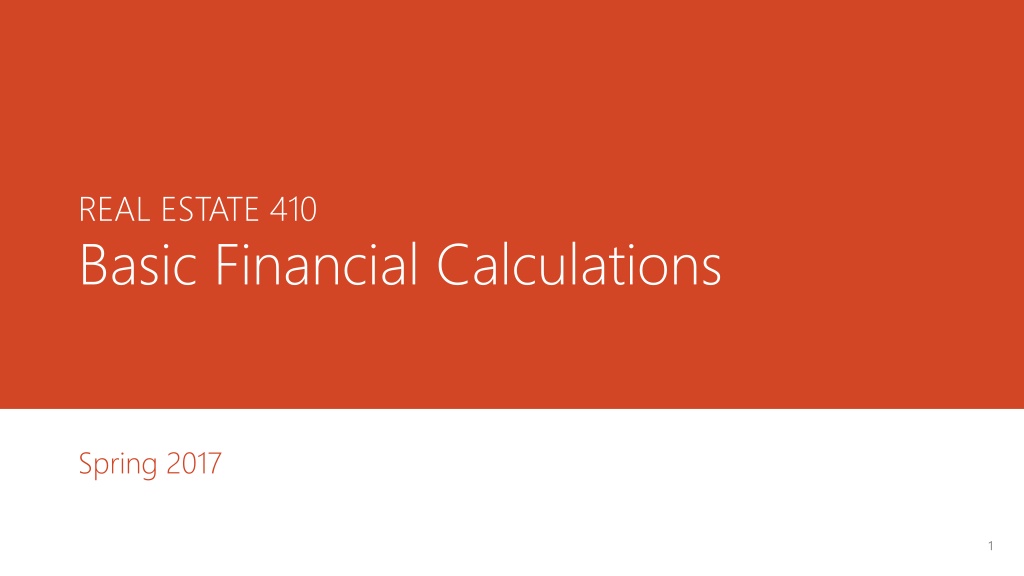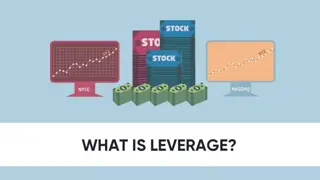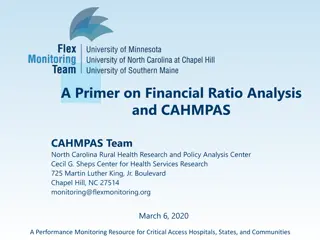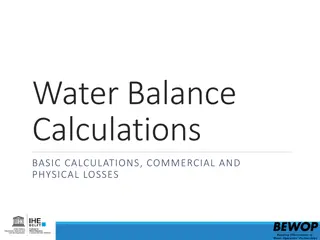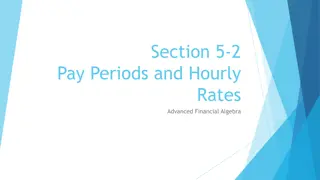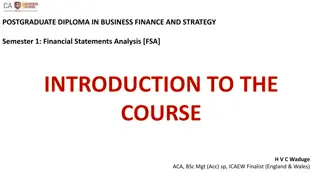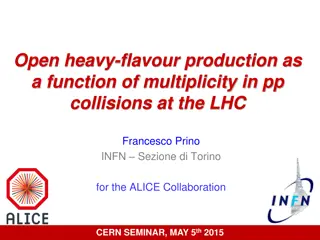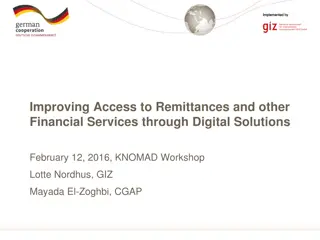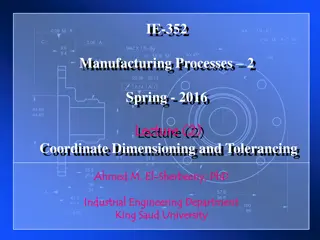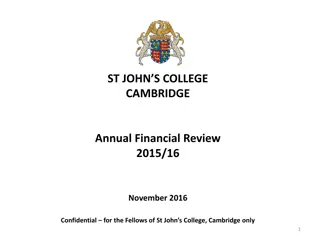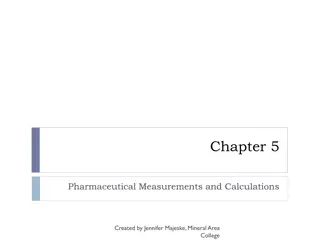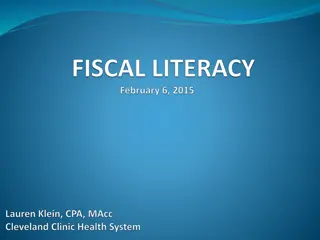Basic Financial Calculations
Real estate transactions involve cash flows at different times. The Time Value of Money (TVM) is crucial as $1 today is not equivalent to $1 in the future. TVM factors include Repayment Risk, Inflation, and Opportunity Cost. Future Value calculations show how investing money now can grow over time with interest. Examples demonstrate compounding annually vs. semi-annually, revealing the impact of multiple compounding periods on future value.
Download Presentation

Please find below an Image/Link to download the presentation.
The content on the website is provided AS IS for your information and personal use only. It may not be sold, licensed, or shared on other websites without obtaining consent from the author. Download presentation by click this link. If you encounter any issues during the download, it is possible that the publisher has removed the file from their server.
E N D
Presentation Transcript
REAL ESTATE 410 Basic Financial Calculations Spring 2017 1
Time Value of Money (TVM) Real estate transactions often involve cash flows materializing at different points in time: Buy a property now, sell it later. Sign a lease now, pay rents monthly over time. Take out a mortgage now, pay it back over time. Buy land now for development, pay for construction and sell the building later. But $1 today is not equivalent to $1 some time in the future! 2 2
TVM Three factors Repayment Risk How certain is repayment? Who do you trust with your money? Inflation $1 tomorrow may not buy as much as it does today Opportunity Cost If I lend/invest $1 in something today, I forego alternative investments or consumption until repaid When comparing investment options, the basis or reference point should be the same 3
Future Value (FV) General Equation ?? ?= ??(1 + ?)? PV : Initial Deposit i : Periodic Interest Rate n : Number of Periods FVn : Value at a specified future period Earning Interest on Interest 4
FV Example 1: What is the value at the end of year 5 of $100 deposited today if the interest rate is 10% compounded annually? FV5 = $100(1.10)5 = $100(1.61051) = $161.05 5
FV Example 1 using a Financial Calculator: PV = $100 n = 5 i = 10 FV = $161.05 6
FV Semi-Annual Compounding In Example1, what if interest were paid semi-annually instead of annually? There would be two compounding periods in each year. There would be a periodic rate to match the multiple compounding periods. The time period would be doubled. Most importantly, the future value would be higher. Additional compounding periods will effect the final result. 7
FV The general equation becomes: ?? ???= ?? 1 +? ? m : number of compounding intervals in a year i/m : periodic interest rate For Example 1: 5 2 ??5= 100 1 +0.1 =100(1.6289)=$162.89 162.89 2 8
FV Notice the difference in Future Value when multiple compounding periods are used: $162.89 vs. $161.05 This shows the effect of earning interest on interest. The more compounding periods there are per year, the higher the future value will be. 9
Present Value (PV) Discounting: converting future cash flows to the present General Equation: 1 ?? = ??? (1 + ?)? Example 2: What is the value today of $2,000 you will receive in year 3 if the interest rate is 8% compounded annually? 1 ?? = ??? (1+?)?= 2000(.7938)=$1,587.66 $1,587.66 10
PV Example 2 using a Financial Calculator: FV = $2000 n = 3 i = 8 PV = $1587.66 11
PV Example 2 now with 8% compounded monthly Mathematically: 1 ?? = ??? (1 +? ?)?? 1 12)5 12= 2000(.7873) = $1,574.51 ?? = 2000 (1 +0.08 12
PV Using a financial calculator: FV = $2000 n.m = 36 i/m = 8/12 PMT = $0 PV = $1574.51 13
Annuities Leveled cash flow stream that terminates at a specific time in the future Ordinary annuity Cash flows begin one period from today (i.e., payments at the end of the periods) Annuity due Cash flows begin immediately (i.e., payment at the beginning of the periods) 14
FV Annuity General equation of FV of an ordinary annuity of a payment P compounding at an annual interest of i over n years. ?? = ?(1 + ?)? 1+ ?(1 + ?)? 2+?(1 + ?)? 3+ + ? or ? 1 (1 + ?)? ?? = ? ?=0 15
FV Annuity General equation of FV of an annuity due of a payment P compounding at an annual interest of i over n years. ?? = ?(1 + ?)?+ ?(1 + ?)? 1+?(1 + ?)? 2+ + ?(1 + ?) or ? (1 + ?)? ?? = ? ?=1 16
FV Annuity Example 3: What is the future value of a 5-year ordinary annuity with annual payments of $200, evaluated at a 15% interest rate? PMT = $200 n = 5 i = 15 PV = $0 FV = $1,348.48 17
FV Annuity General formula of the future value of an ordinary annuity with m annual rate compoundings ?? = ?(1 + ??)?? 1+ ?(1 + ??)?? 2+ + ? or ?? 1 (1 + ??)? ?? = ? ?=0 For Example 3, if payments were to be received monthly, we use the above formula, setting m=12 18
FV Annuity Using a financial calculator PMT = $200 nm = 60 i/m = 15/12 PV = $0 FV = $17,714.90 19
PV Annuity General equation of PV of an ordinary annuity of a payment amount P compounding annually at an interest rate i over n years 1 1 1 1 ?? = ? (1 + ?)+ ? (1 + ?)2+ ? (1 + ?)3+ + ? (1 + ?)? or ? 1 ?? = ? (1 + ?)? ?=0 20
PV Annuity Example 4: If you had the opportunity to purchase a $500 per year, ten-year annuity, what is the most you would pay for it? The interest rate is 8%. Using a financial calculator: PMT = $500 n = 10 i = 8 FV = $0 PV = $3,355 21
PV Annuity Recall our formula for present value of discrete payments: ? 1 ?? = ? (1 + ?)? ?=0 It can be shown that, in the limit as ? this formula becomes: ?? =? ? 22
PV Annuity General formula of the present value of an ordinary annuity with m annual rate compoundings 1 1 1 1 ?? = ? (1 + ?/?)+ ? (1 + ?/?)2+ ? (1 + ?/?)3+ + ? (1 + ?/?)?? or ?? 1 ?? = ? (1 + ?/?)? ?=0 For Example 4, if payments were to be received monthly, we use the above formula, setting m=12 23
PV Annuity Using a financial calculator PMT = $500 nm = 120 i/m = 8 FV = $0 PV = $41,210.74 24
Uneven Cash Flows General equation of future value: ?? = ??1(1 + ?)? 1+ ??2(1 + ?)? 2+??3(1 + ?)? 3+ + ??? General equation of present value: 1 1 1 1 ?? = ??1 (1 + ?)+ ??2 (1 + ?)2+ ??3 (1 + ?)3+ + ??? (1 + ?)? Attention when using a calculator. Each CF is to be entered separately. Easier done with Excel! 25
TVM Extensions Given the basic equations that we have discussed, we can solve for any missing single variable. Some common applications Solve for the interest rate Compute payments to accumulate a future sum Compute payments to amortize a loan 26
TVM Extensions Rate of Return or Discount Rate Example 5: Reed & Portland Trucking is financing a new truck with a loan of $10,000, to be repaid in 5 annual end-of-year installments of $2,504.56. What annual interest rate is the company paying? Solution: PV = $10,000; n = 5; PMT = ($2504.56); FV = $0 i = 8% 27
TVM Extensions Example 6: A bank makes a $100,000 loan and will receive payments of $805 each month for 30 years as repayment. What is the rate of return to the bank for making this loan? Solution: PV = $100,000; nm = 12*30 = 360; PMT = ($805); FV = $0 i = 0.75*12 = 9% 28
TVM Extensions Example 7: Accumulating a Future Sum, i.e., sinking fund problem An individual would like to purchase a home in five (5) years. The individual will accumulate enough money for a $20,000 down payment by making equal monthly payments to an account that is expected to earn 12% annual interest compounded monthly. How much are the equal monthly payments? FV = $20,000; nm = 5*12 = 60; PV = $0; I = 12% PMT = $244.89 29
TVM Extensions In the previous example, the total amounts deposited by our saver over time is: $244.89 x 60 = $14,693.40 The interest earned over time by those deposits was: $20,000 - $14,693.40 = $5,306.60 This is about 1/3rd of the deposits. This is the power of interest compounding! 30
TVM Extensions Example 8: Amortizing a Loan by making fixed payments Your company would like to borrow $100,000 to purchase a piece of machinery. Assume that you can make one payment at the end of each year, the term is 15 years, and interest rate is 7%. What is the amount of the annual payment? PV = $100,000; n = 15; FV = $0; I = 7%; PMT = $10,979.46 31
Nominal Interest Rate It is basically the interest rate charged by the lender and does not necessarily represent the true cost of borrowing. It does not include fees and commissions. Nor does it does reflect interest compounding if the payment period is less than a year. The periodic interest rate is nominal interest rate divided by the number of periods within a year. 32
Annual Percentage Yield (APY) The Annual Percentage Yield (APY) or Annual Percent Rate (APR) is the discount rate which brings the future payment stream back to present value such that it exactly equals the net cash disbursed by the lender Truth in lending Act: It prevents lenders from advertising a low rate and hiding fees. Still confusing because of different practices by lenders APR quoted by lender does not always include all costs of borrowing as we will see later. 33
Effective Annual Yield (EAY) Unlike APR (or APY), the Effective Annual Yield (EAY) reflects the true cost of borrowing. It includes all fees and commissions and considers any interest rate compounding. If no fees or commissions are paid, ??? = (1 +? ?)? 1 Alternatively, one can use this formula for a 1-year loan. ??? = (?? ??)/?? 34
Effective Annual Yield (EAY) The first EAY equation in the previous slide yields the nominal rate as. ? = (1 + ???)1/? 1 ? This is referred to as Equivalent Nominal Rate (ENAR) in the textbook. Don t be confused! For multi-year loans with uneven cash flows and/or fees and commissions, EAY is the Internal Rate of Return (IRR) defined next. 35
Internal Rate of Return IRR is the discount rate that yields a present value of zero. That is, solve: ? ??? 0 = (1 + ???)? ?=0 This equation is solved iteratively. For IRR to make sense, some cash flows must be negative (outflows), some positive (inflows). 36
Excel Functions For complex analysis, Excel is much better than the financial calculator. It is far more powerful and capable. 37
Conclusion Make sure you have a basic financial calculator and know how your calculator works Basic Excel skills required for this course 38
